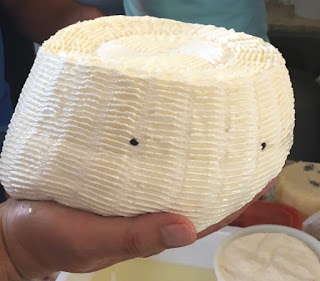Here we are, almost one week away from the New Year. Time to make the Hoppin' John! We're getting our shopping list together and plan to make our Hoppin' John on New Year's Eve day so all the luscious flavors have to time to marinate. Then we'll buy a nice crusty loaf of bread, open a hearty Zin, and enjoy it on New Year's Day.
Wishing you a happy, healthy 2018 filled with peace and love.
**************************************************
Wishing you a happy, healthy 2018 filled with peace and love.
**************************************************
Originally posted 12/29/16
Happy (almost) New Year!
Hope you've had a wonderful holiday so far!
If you've followed the Tour for the last few years, you know that Hoppin' John is our traditional meal on New Year's Day. According to legend, eating black-eyed peas on New Year's Day helps to ensure good luck in the coming year (the peas represent coins). I love that idea, but the main reason we make it is that it's delicious! This is a wonderfully hearty stew/soup, jam-packed with spicy andouille sausage (if you cannot find andouille, you could also use a really good kielbasa), smoked ham, and chopped onions, celery, and garlic (the low country trinity). Serve over rice and top with chopped scallions, a splash of Tabasco and cider vinegar. Add thick slices of crusty bread for sopping up the luscious broth, a green salad, and you're all set. If you like collard greens, you could make that as a side dish (collards represent paper money in the legend).
Wishing you all good things for the New Year!
Black-Eyed Peas with Andouille Sausage and Rice
adapted from "Hot Links and Country Flavors" by Bruce Aidells and Denis Kelly
adapted from "Hot Links and Country Flavors" by Bruce Aidells and Denis Kelly
2 C dried black-eyed peas or 4 C fresh or frozen
1-1/2 LBs andouille sausage or other good quality smoked sausage
1/4 LB chunk of country or smoked ham
6 C chicken stock or water
1 TB bacon grease or olive oil
1 medium onion, finely chopped
1 rib celery, finely chopped
1 TB minced garlic
3 sprigs fresh thyme or 1-1/2 t dried
2 bay leaves
1 or 2 dried chili peppers or 1 t red pepper flakes
1 t freshly ground black pepper
1/2 t pickling spice
salt to taste
4 C cooked rice
chopped green onions, Tabasco sauce, and cider vinegar for serving
1. If using dried peas, rinse and soak overnight in water to cover by 3 inches. Drain, and place in a 6-8 qt pot with a 1/2 LB piece of the andouille, the ham, and the stock. Heat to boiling, then reduce to a simmer. (If using fresh or frozen peas, boil the stock first, then add peas, the 1/2 LB piece of andouille, and the ham. Return to a boil, then reduce to a simmer).
2. Heat the bacon grease or oil in a heavy skillet, add the onion and celery and cook until soft. Add to the peas with the garlic and remaining seasonings. Simmer dried peas for 2 to 2-1/2 hours; fresh or frozen for about 30-45 minutes. In both cases, the peas should be tender and the liquid should begin to thicken.
3. Slice remaining sausage into 1/2 inch rounds. Fry briefly in a nonstick skillet and add to the peas. Remove the whole piece of sausage and the ham and chop roughly; return to the pot. Cook for another 15 minutes. Remove the thyme sprigs, bay leaves, and pepper pods.
4. To serve, ladle pea mixture over rice and sprinkle with green onions, Tabasco, and vinegar to taste.
Yield: 6-8 servings.
Cook's Tour note: we always make this the day before serving to let the flavors meld.
Cook's Tour note: we always make this the day before serving to let the flavors meld.
Eat well, stay warm, be happy.

































































